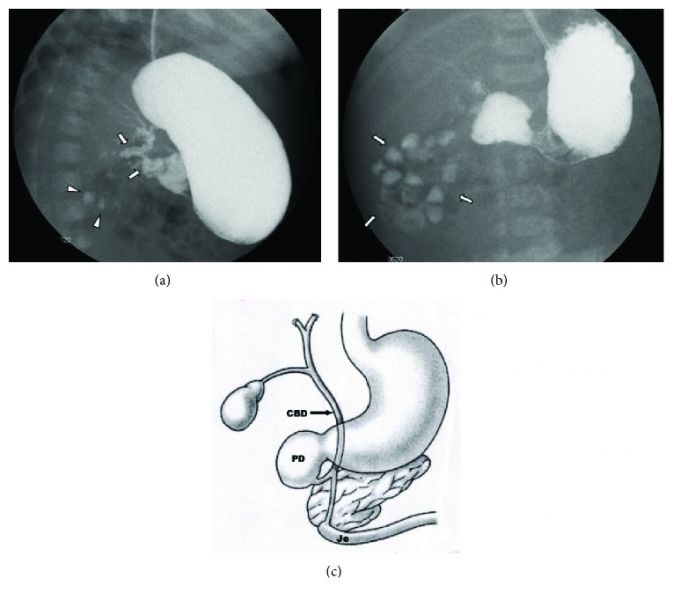File:Duodenal atresia 02.jpg

Original file (765 × 682 pixels, file size: 68 KB, MIME type: image/jpeg)
Duodenal Atresia
(a) Upper gastrointestinal series showing a complete obstruction of the duodenum and contrast filling of anomalous bifurcated bile ducts (arrows). The small contrast was also noted in the distal bowel (arrowheads).
(b) Upper gastrointestinal series showing a complete obstruction at the second portion of the duodenum, and contrast was seen in the proximal jejunum which is located in the right upper quadrant. The proximal location of the jejunum indicates a malrotation of the intestine without evidence of a small bowel obstruction.
(c) Diagram showing biliary tract abnormality associated with duodenal atresia (PD — proximal duodenum, Je — jejunum, and CBD — common bile duct).
Duodenal atresia (DA) occurs in approximately 1 in 2500–7500 live births without a sex-associated difference. Approximately 25–40% of infants with duodenal atresia have Trisomy 21. Approximately 8% of infants with Down syndrome have duodenal atresia. There is also an association of VACTERL anomalies (vertebral, anorectal, cardiac, tracheoesophageal, renal, and limb anomalies).
| ICD-11 LB14 Structural developmental anomalies of duodenum - Any congenital defect of duodenum that results from interference with the normal growth and differentiation of the fetus. Such defects can arise at any stage of embryonic development, vary greatly in type and severity, and are caused by a wide variety of determining factors, including genetic mutations, chromosomal aberrations, teratogenic agents, and environmental factors. Most developmental defects are apparent at birth, especially any structural malformation, but some becomes evident later. |
- Links: duodenal atresia | gastrointestinal abnormalities | image 1 | image 2
Reference
Puvabanditsin S, Botwinick M, Chen CW, Joshi A & Mehta R. (2018). Biliary Tract Abnormalities as a Cause of Distal Bowel Gas in Neonatal Duodenal Atresia. Case Rep Surg , 2018, 8041427. PMID: 30046504 DOI.
Copyright
© 2018 Surasak Puvabanditsin et al. This is an open access article distributed under the Creative Commons Attribution License, which permits unrestricted use, distribution, and reproduction in any medium, provided the original work is properly cited.
CRIS2018-8041427.003.jpg
Cite this page: Hill, M.A. (2024, April 27) Embryology Duodenal atresia 02.jpg. Retrieved from https://embryology.med.unsw.edu.au/embryology/index.php/File:Duodenal_atresia_02.jpg
- © Dr Mark Hill 2024, UNSW Embryology ISBN: 978 0 7334 2609 4 - UNSW CRICOS Provider Code No. 00098G
File history
Click on a date/time to view the file as it appeared at that time.
| Date/Time | Thumbnail | Dimensions | User | Comment | |
|---|---|---|---|---|---|
| current | 16:12, 16 April 2019 |  | 765 × 682 (68 KB) | Z8600021 (talk | contribs) | (a) Upper gastrointestinal series showing a complete obstruction of the duodenum and contrast filling of anomalous bifurcated bile ducts (arrows). The small contrast was also noted in the distal bowel (arrowheads). (b) Upper gastrointestinal series sho... |
You cannot overwrite this file.
File usage
The following page uses this file: